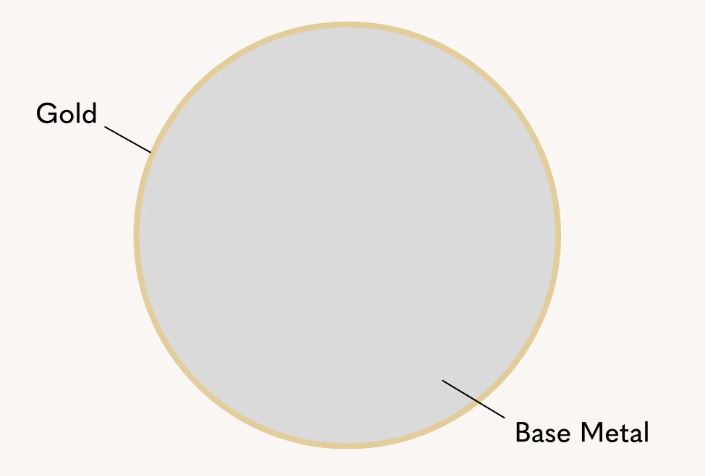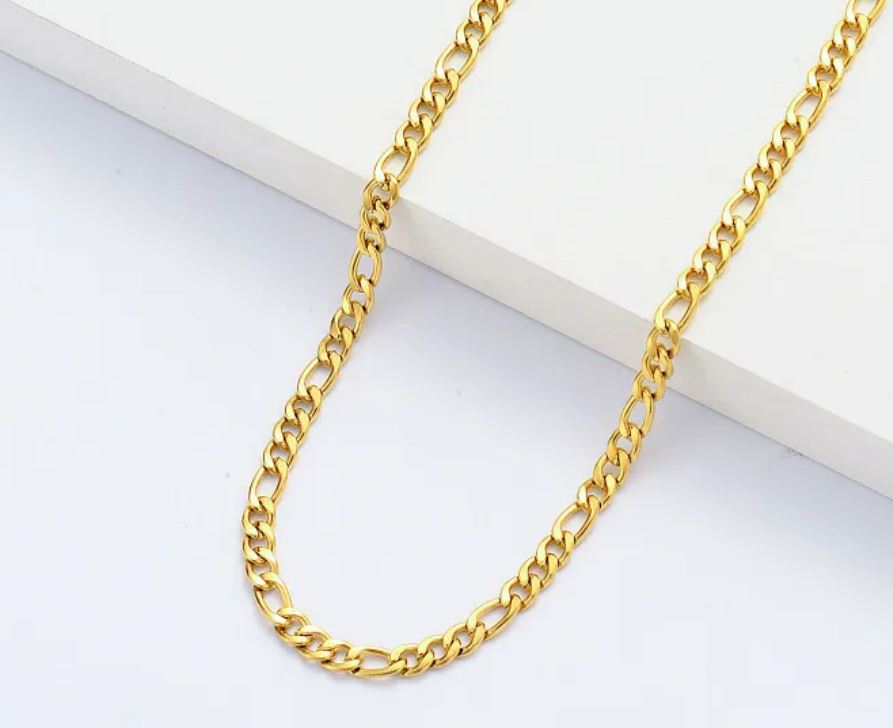Does 14k Gold Plated Tarnish
Yes, 14k gold plated jewelry can tarnish if outer gold layer wears off and base metal is made of sterling silver, copper, brass or bronze. It can also turn green if it is made of copper, brass or bronze. In case of silver, it will turn black. Tarnishing depends on what metal was used as a base. If it is other than the mentioned, then it will not tarnish.
In this article we’ll answer questions like does gold plated tarnish, does gold plated turn green, how long will it take to turn green and how can you save it from tarnishing.
Why Does 14k Gold Plated Tarnish
Before understanding why does 14k gold plated tarnish, we’ll need to understand how does 14k gold plated is made. It is made by plating 14k gold on a base metal. This base metal can be any metal which is cheap and less valuable than gold. Sterling silver, copper, brass, bronze and stainless steel are the most popular ones.
As long as gold plating is on the base metal, it will not tarnish regardless of what the base is. But whenever it wears off, it exposes the base metal to atmospheric chemicals. The metals mentioned above can react these chemicals like sulfur to form tarnish layer.
This process is similar to what happened to the Statue of Liberty, which is made of copper with brownish color. Over time, exposure to air caused it to turn green. In jewelry, this same reaction can also occur.

Does All Gold Plated Jewelry Tarnish?
No. All gold plated jewelry does not tarnish. Only that jewelry is going to tarnish which has a base of any of these metals.
- Copper
- Sterling Silver
- Brass
- Bronze
If metal base is other than these metals like stainless steel, it will not tarnish.
Will Gold Plated Jewelry Turn Green
Yes, it does turn green and can also turn your skin green if base metal is made of copper, brass or bronze. If it is made of sterling silver, it will turn black. Other than that, any metal except these will not turn green or black.
Does 14k Gold Plated Brass Turn Green
Yes, it does turn green due to tarnishing. Once gold plating erodes away, it will 1 to 2 months to tarnish.
Can You Remove Tarnish?
Yes, you can easily remove tarnish. There are many tarnish removing chemicals available in the market. It will cost you around $20 to buy one of these.
What Causes Tarnishing of Gold Plated Jewelry?
Gold plating is a process where a very thin layer of gold is applied to the surface of base metal. While the thin layer of gold provides the luxurious appearance of solid gold, the properties of the underlying metal play a significant role in determining how the jewelry behaves over time.
This gold plating will wear off in some time, no matter how will you take care of it. After that only option you will have to do is to either re-plate it or let it exposed to atmosphere.
Below are the main reasons which can speed up tarnishing.
1. Copper or Brass Base Metals
Many gold-plated jewelry items use copper or brass as the base metal because they are affordable and easy to work with. However, these metals are prone to oxidation when exposed to air, moisture, or certain chemicals. When oxidation occurs, it forms a greenish layer known as patina. This layer can transfer to the skin, leaving a green mark where the jewelry was worn. This is especially common with rings and bracelets, as they are in constant contact with skin and environmental elements.
2. Erosion of the Gold Layer
Over time, the thin gold layer can wear away due to friction, exposure to water, or contact with harsh chemicals. When the base metal is exposed, it reacts with moisture and air, leading to discoloration. Jewelry worn daily, such as rings or necklaces, is more likely to experience this erosion because of frequent handling and exposure to sweat, lotions, and soaps.
3. Sweat
Every individual has a unique skin chemistry, and some people’s sweat is more acidic than others. This acidity can accelerate the tarnishing and oxidation process of the base metal beneath the gold plating. Additionally, the natural oils and salts in sweat can interact with the base metal, causing it to oxidize and transfer green discoloration to the skin.
4. Environmental Factors
Humidity, exposure to perfumes, lotions, cleaning agents, and even saltwater can weaken the gold layer and lead to discoloration. For example, wearing gold-plated jewelry while swimming in chlorinated pools or at the beach can accelerate the degradation of the gold layer and expose the base metal.
What Factors can Affect Tarnishing
Here are some factors which can save your jewelry from tarnishing.
1. Quality of the Plating
High-quality gold-plated jewelry often features a thicker layer of gold, which is less likely to wear off quickly. The better the quality of the plating, the longer it will take for the base metal to become exposed.
2. Base Metal Used
The type of metal used as the base layer greatly affects whether green discoloration occurs. Jewelry with stainless steel or other non-reactive metals as the base is much less likely to turn green compared to those made with copper or brass.
3. Frequency of Wear
Jewelry that is worn daily is more prone to wear and tear, which can expose the base metal. Occasional use can help prolong the life of the gold layer and reduce the chances of discoloration.
4. Skin Type and Environmental Exposure
Individual factors such as sweat, body oils, and exposure to environmental elements can also determine whether gold-plated jewelry will turn green. If you are a person who gets more sweat, then it is better to not wear gold plated jewelry on a hot day. Apart, apply cosmetic items like lotion and perfume before wearing jewelry.

How to Prevent Gold-Plated Jewelry from Tarnishing
While the green discoloration is not entirely avoidable for all gold-plated pieces, there are several steps you can take to minimize the chances of it happening:
1. Avoid Moisture
Moisture is one of the biggest causes of gold plated jewelry turning green. Always remove your gold-plated jewelry before swimming, bathing, or engaging in activities that cause excessive sweating. Moisture accelerates the oxidation process of the base metal.
2. Store Properly
Store your jewelry in a cool, dry place when not in use. Use anti-tarnish pouches or silica gel packets to reduce exposure to humidity. Keeping pieces separate in individual bags or compartments can prevent scratches and reduce wear.
3. Limit Exposure to Chemicals
Avoid contact with perfumes, lotions, cleaning products, and other chemicals that can erode the gold layer. Apply perfumes and lotions before putting on your jewelry.
4. Clean Regularly
Clean your gold-plated jewelry with a soft, lint-free cloth after each use to remove dirt, oils, and sweat. Avoid abrasive materials or harsh cleaning agents that could damage the gold layer. Gold plated jewelry is to be dealt with excessive care during cleaning as plating can wear off on any rough touch.
5. Re-plating Services
If the gold layer begins to wear thin, consider professional re-plating services to restore the original appearance of your jewelry. This process adds a new layer of gold, making the piece look like new. You need to check with your jeweler whether they do it for free or charge a fee for it. This can cost around $25 to $70.
FAQ’s about 14k Gold Plated Tarnish
Here are some FAQ’s about 14k gold plated tarnish.
Does 14k Gold Plated Tarnish
Yes, 14k gold plated does tarnish if gold plating wears off and base is of sterling silver, copper or brass.
Will Gold Plated Turn Green
Yes, it can turn green if base is made of copper or brass.
Does 14k Gold Tarnish
14k gold does tarnish but not easily. Gold plated and gold vermeil jewelry does tarnish quickly within 3 to 4 months of regular use.
Does Gold Turn Green
No. Only those gold plated jewelry items tarnish which have a base of sterling silver, brass or copper.
Is there a Way to Avoid Tarnishing of Silver or Copper?
It is a natural process and it will happen whenever they are exposed to atmosphere. However, if you re-plate your jewelry every time wears off, then it will not happen as base metal will not be exposed.
Conclusion
Gold plated jewelry offers a beautiful and affordable way to enjoy the look of gold, but it requires proper care to maintain its appearance. The green discoloration is not inevitable, but understanding its causes and taking preventive measures can help you keep your pieces looking their best for years to come. By investing in high-quality pieces and following care guidelines, you can enjoy the elegance of gold plating without worrying about unwanted green marks.

